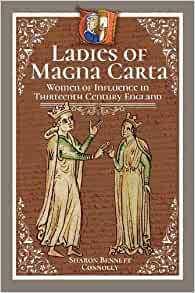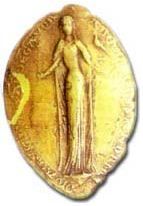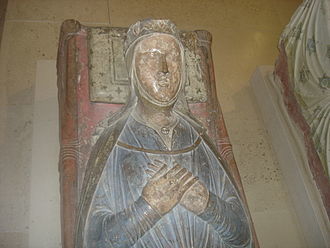Why Isabelle d’Angoulême is hard to love: Guest Post by Sharon Bennett Connolly
I’m delighted to welcome Sharon Bennett Connolly back to my blog! I’ve known Sharon since her blogging days, and was delighted when she began to publish her biographies of historical women, including her brand-new one, Ladies of Magna Carta. Today’s woman, Isabelle of Angoulême, is one who’s long intrigued me. Over to Sharon!

At first sight, it is easy to have sympathy for Isabelle of
Angoulême. When I started researching her for Ladies of Magna Carta: Women
of Influence in Thirteenth Century England, I was expecting to be able to
go some way to redeeming her reputation. She was married at a very young age –
she was no more than 12 and may have been as young as 10 – to ‘Bad’ King John,
the man who would later be accused of murdering his own nephew and left a woman to starve in his dungeons.
Isabelle
d’Angoulême was the only child of Audemar, Count of Angoulême and Alice de
Courtenay. Her mother was the daughter Peter de Courtenay, lord of Montargis
and Chateaurenard, and a cousin of king Philip II Augustus of France. Through
her Courtenay family connections, Isabelle was related to the royal houses of
Jerusalem, Hungary, Aragon and Castile. When John set his sights on her, Isabelle
was betrothed to Hugh IX de Lusignan: the chronicler Roger of Howden maintained
that Isabelle had not yet reached the age of consent, which was why she was
still only betrothed to Hugh, rather than married to him. The marriage between
Isabelle and Hugh was intended to put to bed, literally, a long-running, bitter
rivalry between the Lusignans and the counts of Angoulême. It would also unite
neighbouring regions in Aquitaine, posing a threat to Angevin power in the
region. This could have effectively cut Aquitaine in two, jeopardising the
stability of the borders of Poitou and Gascony. John could not help but see the
threat posed by the impending marriage and sought to put a stop to it. Count
Audemar, it seems, was quite receptive to the suggestion that he abandon the
Lusignan match if it meant that his daughter would become a queen.

In
the early years of their marriage, John appears to have treated Isabelle more
like a child than a wife, which she still was, and she was financially
dependent on him. When she was not at court with the king, Isabelle spent time
at Marlborough Castle or in the household of John’s first wife, Isabella of
Gloucester, at Winchester. Isabella’s allowance was raised from £50 to £80 a
year, to pay for the extra expenses incurred by housing the queen.

It appears that Isabelle was an
unpopular queen, guilty by her association with the excesses and abuses of
John’s regime. It was in this light that John’s marriage to
Isabelle was seen as the start of England’s woes, with some of the blame
falling unfairly on the young queen. Contemporary sources reported that John
spent his mornings in bed with the queen, when he should have been attending to
the business of the country, casting Isabelle as some kind of temptress,
irresistible to the king. The fact that Isabelle did not give birth to her
first child until 1207, when she was in her late teens, puts the lie to these
sources, suggesting that she and John
did not consummate the marriage in the first few years. After 16 years together, the
couple had 5 children; Henry III, Richard of Cornwall, Isabella, Joan and the
youngest, Eleanor, who was born in 1215 or 1216.
While her movements were
restricted and closely controlled during her marriage to John, the situation
did not improve for Isabelle following John’s death in 1216. Their 9-year-old
son Henry was now king, but Isabelle was excluded from
playing a role in the regency government; her unpopularity in England and lack
of political experience were major factors. Moreover, she had had limited
contact with her children: they lived in separate households and Isabelle was
not responsible for their supervision or education, which added to her
isolation. Almost
as soon as Henrys crowned, Isabelle started making arrangements to go home, to
Angoulême, of which she was countess in her own right. In 1217 she left England.
Once in her own domains,
Isabelle was to arrange the wedding of her daughter, Joan. Joan had been betrothed, at the age of 4, to Hugh X
de Lusignan, Count of La Marche and the son of Hugh IX, the man who had been
betrothed to Isabelle before John married her. In 1220 Isabelle shocked England, and probably the
whole continent, when she scandalously married her daughter’s betrothed herself.
Poor 9-year-old Joan’s erstwhile fiancé was now her
stepfather! Worse was to come, however, when the little princess was not
returned to her homeland, as might have been expected, but held hostage, by Isabelle
and Hugh, to ensure Hugh’s continued control of her dower lands, and as a
guarantee to the transfer of her mother’s dower, which the English government
was withholding against the return of Joan.
Stalemate.
Isabelle wrote to
her son, Henry III, to explain and justify why she had supplanted her own
daughter as Hugh’s bride, claiming ‘…lord Hugh of
Lusignan remained alone and without heir in the region of Poitou, and his
friends did not permit our daughter to be married to him, because she is so
young; but they counselled him to take a wife from whom he might quickly have
heirs, and it was suggested that he take a wife in France. If he had done so,
all your land in Poitou and Gascony and ours would have been lost. But we,
seeing the great danger that might emerge from such a marriage – and your
counsellors would give us no counsel in this – took said H[ugh], count of La
Marche, as our lord; and God knows that we did this more for your advantage
than ours…’

Ironically, Isabelle
had now achieved that which King John had hoped to avoid; the union of La
Marche and Angoulême, splitting Angevin Aquitaine down the Little Joan was
finally returned to England towards the end of 1220, but the arguments over
Isabelle’s English lands continued throughout the 1220s and beyond. Isabelle
would not retire in peace and in 1224 she and Hugh betrayed Henry by allying
themselves with the King of France. In exchange for a substantial pension, they
supported a French invasion of Poitou (the lands in France belonging to the
King of England, her son). They were reconciled with Henry in
1226 and Isabelle met her first-born son for the first time in more than twelve
years in 1230, when Henry mounted a futile expedition to Brittany and Poitou.
Isabelle and Hugh, however, continued to play the kings of France and England
against each other, always looking for the advantage. In 1242, for example,
when Henry III invaded Poitou, Hugh X initially gave support to his English
stepson, only to change sides once more, precipitating the collapse of Henry’s
campaign. Isabelle herself was implicated in a plot
to poison King Louis IX of France and his brother, only to be foiled at
the last minute; the poisoners claimed to have been sent by Isabelle. There is
no evidence of Isabelle denying the accusation, but she never admitted her
guilt, either.
Isabelle’s second marriage proved even
more unstable than her first, shaken by Hugh’s frequent infidelities and
threats of divorce. Isabelle enjoyed greater personal authority within her
second marriage; where she had issued no charters whilst married to King John,
as Hugh de Lusignan’s wife, the couple issued numerous joint charters. Her difficult
relationship with France added to Isabelle’s marital problems. In one instance,
Isabelle was offended by the queen of France when she was not offered a chair
to sit, in the queen’s presence, regardless of the fact she herself was a
crowned and anointed queen. Following this insult, in 1241, Isabelle castigated
Hugh de Lusignan for supporting a French candidate to the county of Poitou,
ahead of her son, Henry III. In retaliation, Isabelle stripped Lusignan Castle
of its furnishings and refused to allow her husband into her castle at
Angoulême for three days.
Despite the rocky relationship,
Isabelle and Hugh had nine children together, including Aymer de Lusignan and
William de Valence. Many of his Lusignan half-siblings would later cause
problems for Henry III, having come to England to seek patronage and
advancement from their royal half-brother.
As
contemporaries described her as ‘more Jezebel than Isabel’, accused her of
‘sorcery and witchcraft’, Isabelle of Angouleme’s reputation as a heartless
mother and habitual schemer seems set to remain. Married to King John whilst
still a child, she was castigated as the cause for the loss of the majority of John’s
continental possessions and the subsequent strife and civil war; one could
easily sympathise with her lack of love for England. That Isabelle abandoned
the children of her first husband within months of his death, and her apparent
willingness to betray her son for her own ends goes some way to destroy the
compassion one may have felt for her.
That being said, Isabelle d’Angoulême is a
fascinating character!

Author bio:
Sharon Bennett Connolly has been fascinated by history her whole
life. She has studied history academically and just for fun – and even worked
as a tour guide at historical sites. For Christmas 2014, her husband gave her a
blog as a gift – www.historytheinterestingbits.com – and Sharon started
researching and writing about the stories that have always fascinated,
concentrating on medieval women. Her latest book, Ladies of Magna Carta:
Women of Influence in Thirteenth Century England, released in May 2020, is
her third non-fiction book. She is also the author of Heroines of the
Medieval World and Silk and the Sword: The Women of the Norman Conquest.
Sharon regularly gives talks on women’s history; she is a feature writer for All
About History magazine and her TV work includes Australian Television’s ‘Who
Do You Think You Are?‘

Links:
Blog:
https://historytheinterestingbits.com/
Facebook: https://www.facebook.com/Thehistorybits/
Twitter:
@Thehistorybits
Pen & Sword
Books: https://www.pen-and-sword.co.uk/Ladies-of-Magna-Carta-Hardback/p/17766
Amazon: mybook.to/LadiesofMagnaCarta



